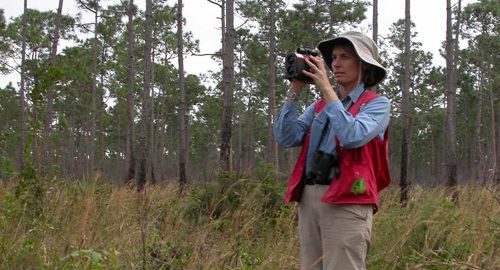Professor Janet Franklin recently contacted UCSB Geography with the news that her latest book, Mapping Species Distributions: Spatial Inference and Prediction (Ecology, Biodiversity and Conservation) has been published by Cambridge University Press: “a book which I think may be really useful to geographers, so I want to get the word out.” According to the press release, the book “comprehensively addresses all aspects of species’ distribution modeling, creating a concise source of tools for use academically and in the field; includes an extensive review of published literature, providing a sound basis for a new approach to future modeling; and is suitable for undergraduate and graduate students new to species’ distribution modeling and to assist more-experienced researchers and resource and conservation managers.”
Dr. Franklin received her BA in Environmental Biology in 1979, her MA in1983, and her PhD in 1988 in Geography, all from UCSB: “My mentors included David Simonett and Jack Estes who I greatly miss. I was a professor of Geography, starting in 1988 at San Diego State University where I joined the faculty of the joint SDSU-UCSB doctoral program when that program was initiated, and I supervised several doctoral students in that program (Peter Scull, John Rogan, Jen Miller, Alex Syphard) who have all gone on to make SDSU/UCSB Geography proud. I have served on doctoral committees of UCSB students, including, currently, Seth Peterson (Dar Roberts’ lab). I have collaborated and published with UCSB faculty over the years. I recently left SDSU to join the faculty in the School of Geographical Sciences and Urban Planning at Arizona State University.”
Mapping Species Distributions is now available through Cambridge University Press and Amazon and is in the UCSB Library. To quote one of the reviewers, “Whether you are a student, professor, or experienced species distribution modeler, this book will have something to teach you. As far as I know, this is the only book that truly provides a comprehensive foundation in species distribution modeling. It starts with the history and applications of SDM and the ecological concepts that drive the modeling; then discusses data requirements and issues; covers modeling methods and considerations; and ends with a discussion of model evaluation and implementation. The writing style is casual and very digestible, but the text is also rich with citations to the most recent literature on the topic. Indeed, there are more than 50 pages of references! I’ve learned a ton from reading this book, and I highly recommend it.”
Dr. Franklin’s research is focused on in the dynamics of terrestrial (land) plant communities at the landscape scale. Her work addresses the impacts of human-caused landscape change on the environment. Human land use — agriculture and urbanization — and other large-scale human impacts such as global warming, and the introduction of exotic species, often interact with natural disturbance regimes, such as fire, flooding and hurricanes, to shape plant community dynamics (succession). How resilient are ecological communities to these impacts? Terrestrial plant communities are important elements of regional biodiversity and provide essential habitat for more charismatic animal and rare plant species. Janet and her students are currently working on: a) methods for predicting species distributions from environmental variables to study the impacts of climate change and land use change on biodiversity; b) exploring the impacts of anthropogenically-altered fire regimes and land use change on flora and fauna in southern California and elsewhere using spatially explicit landscape simulation models and long-term datasets; and, c) understanding the long term impacts of human and natural disturbance on tropical forest island ecosystems in the Pacific and Caribbean. They use many research tools, including field surveys, statistical modeling, computer simulation, remote sensing, spatial analysis, and geographic information systems” (source).




